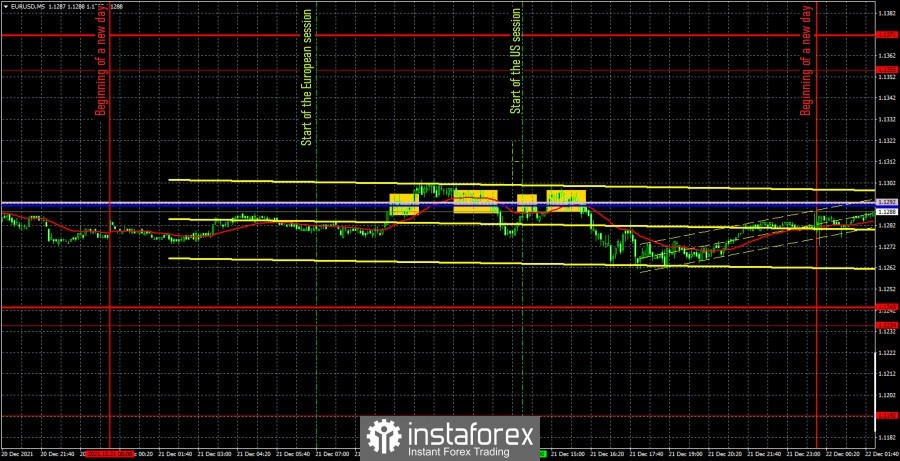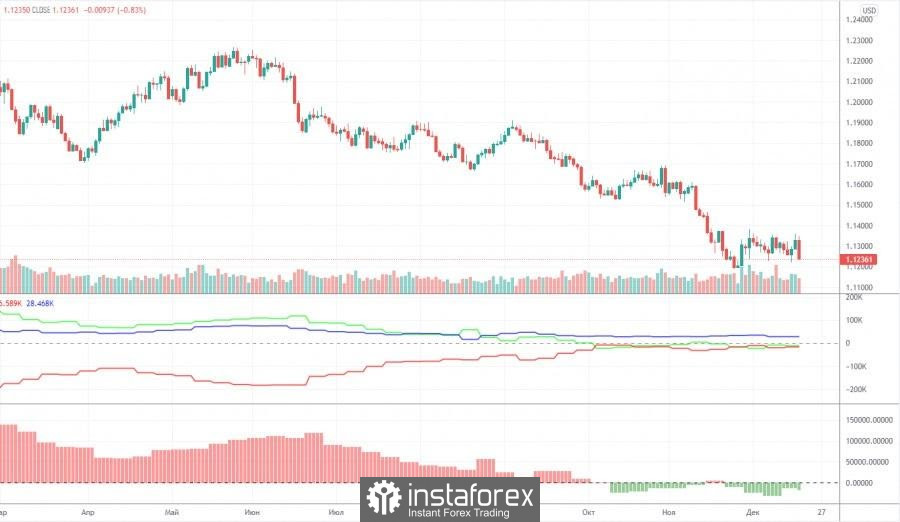EUR/USD 5M

Yesterday, the EUR/USD pair continued to show a movement that was very difficult to predict, both from a technical point of view and from a fundamental one. Let's break it down briefly. In the first half of the day, the pair moved exclusively sideways, and the volatility was 30 points. In the second half of the day, a more or less tangible downward movement began, which, however, did not bring the pair out of the horizontal channel of the 1.1234-1.1355 hourly timeframe and was not based on any macroeconomic or fundamental events, since they simply did not exist on Tuesday. Also, this downward movement was not triggered by a strong sell signal. It turns out that it could not have been predicted in any way. In such a situation, we could only consider the trading signals on Tuesday, although everything was unappealing here. All trading signals of the day formed near the lines of the Ichimoku Senkou Span B and Kijun-sen indicator. In yesterday's review, we said that lines lose their strength in flat conditions. Therefore, the signals that formed around them should have already been ignored. There are a lot of flat factors now: holiday weeks, 1.1234-1.1355 horizontal channel, lack of "foundation" and "macroeconomics", merging of Kijun-sen and Senkou Span B lines, direction of Bollinger bands at 4-hour TF sideways.
EUR/USD 1H

You can clearly see that the pair continues to trade exclusively between the levels of 1.1234 and 1.1355 on the hourly timeframe. Thus, there is simply nothing to add to yesterday's conclusions, since the technical picture has not changed at all on Tuesday. If the markets manage to withdraw the pair from the horizontal channel in the coming days, then it will still be possible to count on a small trend in the last days of the year, but the probability of this is extremely low, since there are no factors for the trend movement now. We highlight the following levels for trading on Wednesday - 1.1192, 1.1234, 1.1355, as well as the Senkou Span B (1.1288) and Kijun-sen (1.1291) lines. The Ichimoku indicator lines can change their position during the day, which should be taken into account when looking for trading signals. Signals can be "rebounds" and "breakthroughs" of these levels and lines. Do not forget about placing a Stop Loss order at breakeven if the price moves 15 points in the right direction. This will protect you against possible losses if the signal turns out to be false. We also take into account the fact that the pair is now flat, so the lines of the Ichimoku indicator are weak. No interesting event and macroeconomic report in the European Union on December 22. However, a report on GDP in the third estimate for the third quarter will be released in the US, as well as an indicator of consumer confidence. However, we do not believe that these reports will be able to influence the market sentiment and help bring the pair out of the horizontal channel.
We recommend you to familiarize yourself:
Overview of the EUR/USD pair. December 22. New Year's holidays are likely to be under siege because of the Omicron.
Overview of the GBP/USD pair. December 22. 90,000 cases per day, but Boris Johnson refuses to introduce a "lockdown".
Forecast and trading signals for GBP/USD for December 22. Detailed analysis of the movement of the pair and trade deals.
Analysis of the COT report

The mood of non-commercial traders has become... a little more bearish during the last reporting week (December 7-13). The "non-commercial" group of traders now has more short positions than long ones, but this advantage is minimal. The difference is only 18,000 contracts, which is not so much. During the reporting week, professional traders closed 7,200 buy contracts (longs) and 2,800 sell contracts (shorts). Thus, the net position of professional players decreased by 4,000. However, the main thing to note is that the green and red lines of the first indicator (indicating the change in the net positions of the non-commercial and commercial groups) have been near the zero level for a long time, as well as in close proximity to each other. That is, in the last few months, when the European currency continued to fall against the dollar, the major players no longer increased their shorts. Thus, the question arises, why did the euro fall at all if market participants did not sell it? Perhaps global factors, such as changes in the balance between the EU and US money supply, are interfering in the exchange rate formation process again. But according to the Commitment of Traders (COT) reports, we can only conclude that the bearish mood is minimal and has not intensified in recent months. Nevertheless, taking into account the fundamental background, the euro may continue to fall. And the technical picture does not yet give any reason to assume the completion of the fall of the euro currency. The mood of the major players remains bearish, but at the same time the bulls do not seek to change anything.
Explanations for the chart:
Support and Resistance Levels are the levels that serve as targets when buying or selling the pair. You can place Take Profit near these levels.
Kijun-sen and Senkou Span B lines are lines of the Ichimoku indicator transferred to the hourly timeframe from the 4-hour one.
Support and resistance areas are areas from which the price has repeatedly rebounded off.
Yellow lines are trend lines, trend channels and any other technical patterns.
Indicator 1 on the COT charts is the size of the net position of each category of traders.
Indicator 2 on the COT charts is the size of the net position for the non-commercial group.
 English
English 
 Русский
Русский Bahasa Indonesia
Bahasa Indonesia Bahasa Malay
Bahasa Malay ไทย
ไทย Español
Español Deutsch
Deutsch Български
Български Français
Français Tiếng Việt
Tiếng Việt 中文
中文 বাংলা
বাংলা हिन्दी
हिन्दी Čeština
Čeština Українська
Українська Română
Română

